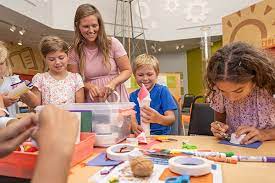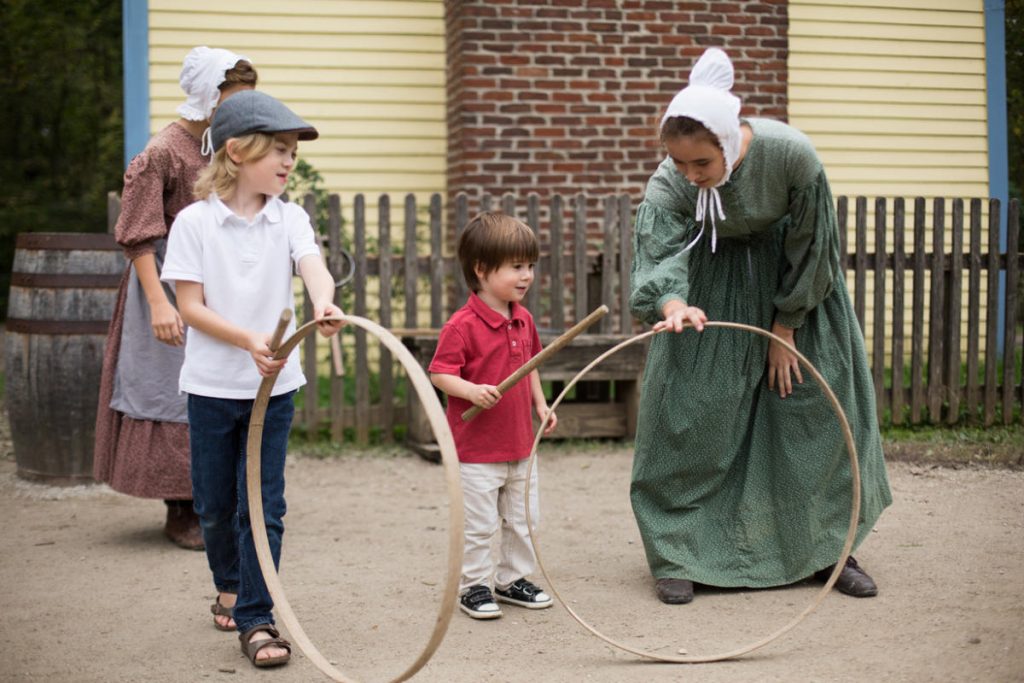 This new experience will celebrate innovation and give children and families the opportunity to explore their inventive creativity through hands-on discovery and learning. The aim is to communicate invention is a process, rather than a single “Aha!” moment. Visitors are provided with opportunities to explore the invention process and their own creativity and to demonstrate the central role that invention plays in American history—and today. Items from Conner Prairie’s collection will be featured along with stories of young inventors from the past.
This new experience will celebrate innovation and give children and families the opportunity to explore their inventive creativity through hands-on discovery and learning. The aim is to communicate invention is a process, rather than a single “Aha!” moment. Visitors are provided with opportunities to explore the invention process and their own creativity and to demonstrate the central role that invention plays in American history—and today. Items from Conner Prairie’s collection will be featured along with stories of young inventors from the past.
“Our mission at Conner Prairie is to offer a unique historic place that inspires curiosity and fosters learning by providing engaging and individualized experiences for everyone, said Jesse Kramer, Director of Exhibits at Conner Prairie. “Spark!Lab is an extension of this mission, providing learning opportunities for children and families to become inventors through their own creativity, innovation, collaboration and problem-solving skills.”
Visitors may be making a marble-powered musical soundscape, clean plastic pollution from the oceans., or build a vehicle. Spark!Lab will feature different invention challenges regularly (e.g., things that roll, things that help us see) so no two visits are alike.
Spanning more than 1,000 wooded acres in Central Indiana, Conner Prairie welcomes more than 400,000 visitors of all ages annually. As Indiana’s first Smithsonian Affiliate, Conner Prairie offers various outdoor, historically-themed encounters and indoor experiential learning spaces that combine history and art with science, technology, engineering and math to offer an authentic look into history that shapes society today.
To learn more, about the Conner Prairie Spark!Lab, visit https://www.connerprairie.org/sparklab-2/. To learn more about other Conner Prairie exhibits, visit https://www.connerprairie.org/explore/experiences/.
 Habitat is another new exploratory exhibit, featuring eleven themed exhibit sections where visitors can discover various nature-related content areas such as bird nests, biomes, keystone species and coral reefs.
Habitat is another new exploratory exhibit, featuring eleven themed exhibit sections where visitors can discover various nature-related content areas such as bird nests, biomes, keystone species and coral reefs.
Habitat was developed by Smithsonian Gardens and focuses on the importance of habitats to our culture and our lives. It explores the critical need for varied habitats, how interconnected and fragile they are, and what we can do to protect them. Habitats provide homes for all living things, from the tiniest ant to the tallest tree. The exhibition is made available by the Smithsonian Institution Traveling Exhibition Service.
Located in currently accessible guest arrs on specific days.
The future goal of Connor Prairie is to change the way the world views and uses museums. Their brochure says it best, so come on! Step into the Story.
In the early 1800s, a man named William Conner lived in a log home near the White River with his Lenape Indian spouse, Mekinges, and their six children. To make a living, he bought furs from Indians who trapped the rich forests of Indiana. His descendants sold his land in 1871. The land went through several owners until purchased by Indianapolis businessman Eugene Darrach in 1915. During that time, the house in which Conner lived underwent many changes.
In 1934, Eli Lilly, then president of pharmaceutical company Eli Lilly and Co, bought the 111-year old structure.
 Lilly believed history was an essential cornerstone of American democracy and immediately began using it as the centerpiece for historical re-enactments to connect people with history in ways books could not. A champion of education, Lilly opened the house and surrounding land to the public so people could see their heritage brought to life.
Lilly believed history was an essential cornerstone of American democracy and immediately began using it as the centerpiece for historical re-enactments to connect people with history in ways books could not. A champion of education, Lilly opened the house and surrounding land to the public so people could see their heritage brought to life.
That was first phase of Conner Prairie. The second phase began in the 1970s when museum director Myron Vourax worked with renowned folklorist Henry Glassie to create a living history museum, a place where the staff dresses, acts and speaks as if they were currently living in the mid-1800s. What’s now known as 1836 Prairietown opened.
Today, Conner Prairie is a place where families engage, explore and discover what it was like to live in Indiana’s past. Every visit is a unique adventure that provides an authentic look into the history that shapes us today.
Our vision is to expand the boundaries of our historical and natural resources by exploring, celebrating, and improving the human experience. Through a heart for the past, a head for the present, and an eye to the future, our doors are always open to a diversity of voice and limitless experiences.
 Extended Weekend Getaways
Extended Weekend Getaways 
